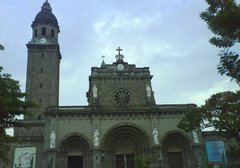
Feast Day of Sto. Niño de Tondo
By: Ms. Rose Marie Mendoza
The feast day of Sto. Niño in Tondo is celebrated in the third Sunday of January. The fiesta in Tondo has the biggest participation in Manila, not only because Tondo is the most populous district in the city and poorest but perhaps because of the many anecdotes connected with the Sto. Niño of Tondo. According to Philippine Historical Commission, the peoples of Tondo celebrated the feast day with a fluvial procession that “attracted thousands of visitors.” Tondo’s terrain at that time consisted of waterways and tributaries which were connected to Manila Bay, a probable reason why the present stone church of Tondo was constructed on elevated ground (several meters above sea level) to prevent sea waters from inundating the Church.
Nick Joaquin, inhis book entitled Almanac for Manileños (Published in 1979) describes the previous celebrations of the fiesta:
“At four in the afternoon on the visperas (meaning the Saturday before) the Sto. Niño of Tondo is borne to the sea by a dancing crowd among which groups of women in pastora hats, or in katipuneda attire: white camisa, red saya. The dancing is through sunny streets hung with bunting and here and there will be a giant heart of bell that opens up as the Sto. Niño passes to unloose a shower of petals. Everyone dances, even the barefoot men bearing the image and the boys bearing standard or farol.
At North Harbor waits the great pagoda with turreted altar. The Sto. Niño embarks, along with everybody who can squeeze abroad and the pagoda moves through the flaming hues of the sunset escorted by fishing fleets bedecked with banners the smaller boats racing each other round and round the pagoda. Dusk falls as the flotilla sails northward along the bay. On the pagoda the dancing continues but the trip has also become a picnic as the good old custom of caridad showers forth bags of biscuits and baskets of native oranges. The Sto. Niño moves in a blaze of light on the waters of his city. The voyage ends at the landing in the Velasquez and Pritil, densest tenement of Tondo is even livelier because folks back from school or works join in the merriment and besides, it’s always more fun to dance under the stars than under the sun. Parents not only from Tondo or Manila but also from the province come to dance before the Sto. Niño to pray for a sick child or give thanks for a child’s recovery.
There were attempts in the past to revive this amphibious celebration as a form of thanksgiving after the Sto. Niño was recovered in August 2, 1972. It was discovered missing from the church altar the previous weeks, July 14, to be exact. Every August 2, since 1973, the Sto. Niño placed on top of a decorated pagoda being paraded along Canal de la Reina, a large polluted estero near intersection of Pritil Market and Tayuman Street. Thousands of people lined both sides of the iron-fenced estero several boats follow the pagoda bearing the images as it travels toward the Dagupan area where a crowd of processioners accompanied the Sto. Niño by land back to the church.
In 1983 Bishop Amado H. Paulino, then the priest ordered a stop to the fluvial parade. Through rapid urbanization has made the fluvial procession of Tondo a thing of the past as many of the waterways have either been reclaimed or have small canals and esteros, residents still awaits the feast day of Sto. Niño with anticipation and excitement.
As early as the first week of January, traditional fairs are set up along Tondo’s side streets, most of the time occupying even half of the two-way traffic lanes. Hanging over practically all streets are banderitas which residents have painstakingly cut, trimmed, and pieced together months earlier. In some streets, where the procession is expected to pass the banderitas are more intricately made and more meticulously laid-out in-between houses complete with bamboo archways and steamers proclaiming “Viva El Sto. Niño.” The annual fiesta processions are held twice, one in the morning and the other just before the sunset. They pass the major streets, stopping occasionally as the participants in the procession watch a display of fireworks, a couple of doves set loose from the hanging gilded cage or a shower of residents stay in their homes to receive guests both invited and uninvited.
There are several stories woven about the church and the miraculous image. It is said that during the Spanish-American war, the Tondo church was used by the American forces as their quarters. Within 24 hours, all the US troops quartered in the church contacted smallpox and the contingent force had to leave the church premises.
In 1943, the church was also converted by the Japanese troops into their military headquarters. Sounds of children crying from nowhere bothered the Japanese troops to much that they abandoned the church.
When the liberation of Manila took place in February 1945, the Japanese set the church on fire. Msgr. J. Jovellanos, the parish priest evacuated the Church taking with him the image of the Sto. Niño. The Tondo devotees who were following the image in safety did not suffer so much as a scratch amidst the crossfire of bullets and mortal shells."




No comments:
Post a Comment